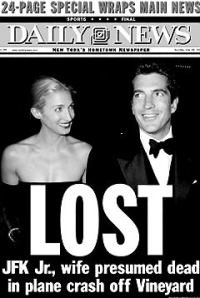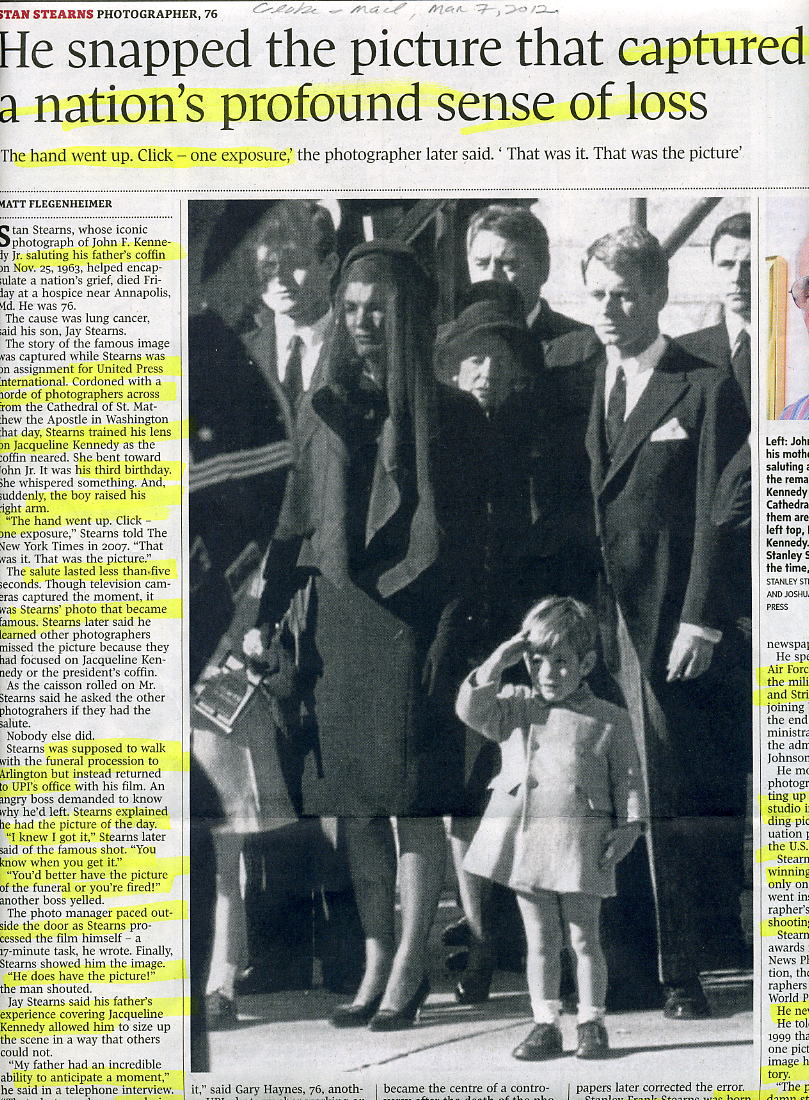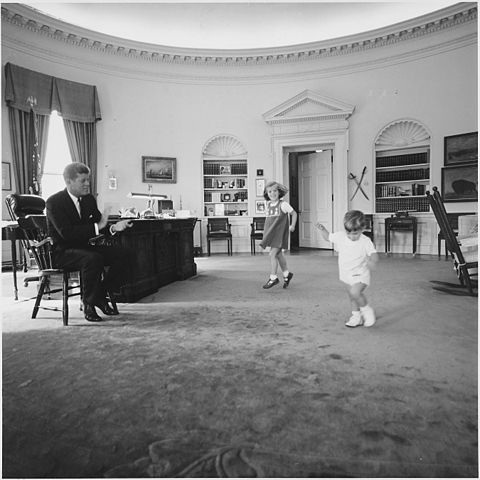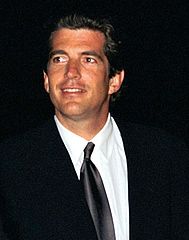 (Reminded by a news story that we’ve reached the 14th anniversary of the death of John F. Kennedy, Jr., I recalled that I’d written something about it at the time, which I published in November 1999 in a bi-weekly column I then ran in a local giveaway newspaper, the Star-Reporter chain, which had a circulation of about 60,000 here on Staten Island. Subsequently I put it online in a section of The Nearby Café devoted to life here in “the forgotten borough.” On the assumption that few readers of this blog have drilled down into that archive, I’m republishing it here, with a few minor revisions. ― A. D. C.)
(Reminded by a news story that we’ve reached the 14th anniversary of the death of John F. Kennedy, Jr., I recalled that I’d written something about it at the time, which I published in November 1999 in a bi-weekly column I then ran in a local giveaway newspaper, the Star-Reporter chain, which had a circulation of about 60,000 here on Staten Island. Subsequently I put it online in a section of The Nearby Café devoted to life here in “the forgotten borough.” On the assumption that few readers of this blog have drilled down into that archive, I’m republishing it here, with a few minor revisions. ― A. D. C.)
Golden Boy as Camera Fodder
 No one paid closer attention to the media feeding frenzy surrounding the death of John F. Kennedy, Jr. on July 16, 1999 than Steven Brill. In his analysis of the press coverage of that event in his then-new, short-lived magazine, Brill’s CONTENT, the eponymous periodical’s chairman and editor-in-chief considered and critiqued the media’s increasing intrusion into private life generally and their especially aggressive behavior toward what we might call “the high-profile children of tragedy” ― such as the offspring of Caroline Kennedy Schlossberg in the immediate aftermath of J.F.K., Jr.’s demise, along with his wife and sister-in-law, in a plane crash that summer. (See his feature story, “Curiosity vs. Privacy,” in Brill’s CONTENT, Vol. 2, no. 8, October 1999, pp. 98-103ff.)
No one paid closer attention to the media feeding frenzy surrounding the death of John F. Kennedy, Jr. on July 16, 1999 than Steven Brill. In his analysis of the press coverage of that event in his then-new, short-lived magazine, Brill’s CONTENT, the eponymous periodical’s chairman and editor-in-chief considered and critiqued the media’s increasing intrusion into private life generally and their especially aggressive behavior toward what we might call “the high-profile children of tragedy” ― such as the offspring of Caroline Kennedy Schlossberg in the immediate aftermath of J.F.K., Jr.’s demise, along with his wife and sister-in-law, in a plane crash that summer. (See his feature story, “Curiosity vs. Privacy,” in Brill’s CONTENT, Vol. 2, no. 8, October 1999, pp. 98-103ff.)

New York Daily News front page for July 18, 1999.
In drawing a proposed line between the permissible and the impermissible, Brill wrote eloquently of what he saw as abuse of press privileges in the publishing of pictures of Schlossberg’s children made in public during that family crisis. Living up to its own proposed standards of responsibility, his magazine blacked or whited out all portrayals of those youngsters when they reproduced magazine covers that, Brill argued, used inappropriate depictions of the Schlossberg kids en route to funeral services and other family events related to this private loss.
As a contrary example of an appropriate press image of an orphaned child, however, Brill suggested Stan Stearns’s iconic 1963 image of J. F. K., Jr. ― then three years old, and known to the world as John-John ― saluting his father’s passing coffin. Brill referred to this as a “famous and clearly newsworthy camera shot.” Methinks he missed his own point, and failed to note some remarkable irony in this situation. The motto of Brill’s CONTENT, “Skepticism is a virtue,” applies here as well. (Brill recently hit the headlines as a result of his March 4, 2013 cover story for Time magazine, “Bitter Pill: Why Medical Bills Are Killing Us,” so he’s a journalist to take seriously.)
•
A moment’s reflection on the part of anyone who knows anything at all about the behavior of small children leads to the inevitable conclusion that saluting the boxed-up and invisible dead as they’re wheeled through the streets on parade is not the spontaneous behavior of three-year-old boys. It’s especially untypical of three-year-old boys brought up in peacetime and not subjected to the routine rituals of military funerals in war-torn countries (in which case they might come to mimic, if not comprehend, such gestures).
It would not be the impulsive act of of a normal three-year-old child of unfamous parents whose father had been murdered or died from other causes. Nor would it plausibly be the instinctual response of a child that age whose famous father had been assassinated, enacted entirely of his own volition while standing in a funeral cortege surrounded by thousands of adult strangers after several days of total chaos in his immediate environment.

Obituary of photographer Stan Stearns, Toronto Globe & Mail, March 7, 2012.
What three-year-old child does that, precisely on cue? (We know it’s on cue because, watching the videotape closely, we can see his mother bend down to prompt him and relieve him of some toy, pushing him forward a step or two just as the casket passes.) What child snaps to attention at just the right moment? Why, a child who’s been very carefully coached to give a command performance in the public eye.
For what reason would someone rehearse that with him? Not for the purposes of personal grief management; what consolation would a bereaved and bewildered toddler find in a ritual act whose significance he can’t possibly understand? No, John-John was trained and then prompted to salute for the cameras, according to a script, on an occasion of public myth-making, in the service of adult others, for motives that had nothing whatever to do with his own emotional needs of the moment.
Appropriate and newsworthy? Or simply the logical extension of a golden boy’s childhood of public service as camera fodder? It should have given Steven Brill, and the rest of us, pause, then ― and should do so now.
•

President John F. Kennedy, Caroline Kennedy, John F. Kennedy, Jr., White House, Oval Office, October 10, 1962. Photocraph by Cecil Stoughton. Courtesy National Archives and Records Administration.
Because that was the story of J. F. K., Jr.’s life. Before the Kennedys, no family in the public eye ― excepting a few show-biz families like that of Ozzie and Harriet Nelson, who brought their children into the act, something we always forgave theater folk ― had ever exploited its children so ruthlessly to gain and maintain public favor. For presidents, indeed for politicians generally, the occasional planned photo op with the family was the rule; just about anything else on the part of the press was clearly off-limits, and widely understood as such.
From the start of J. F. K.’s presidential campaign until his death, the Kennedys granted license to Jacques Lowe and other photographers to roam not only the motels and busses of the campaign trail but, after the election, Air Force One and the White House grounds and offices and corridors ― and, beyond that, the private areas of the White House, the private “compound” of the family’s New England home base, the entire clan’s private sailing boats and beaches ― for the express purpose of providing images of Kennedy-style backstage and family life to a hungry media and an infatuated international audience. In doing so, they effectively erased the line between public and private in the media, and in the mind(s) of the citizenry ― perhaps permanently.
The kids were so charming that we hardly noticed. This was all done in the name of a new informality and openness and youthfulness. (Given what we know now about the secrets of Camelot, the motives may have been less wholesome.) Certainly the public lapped up pictures of Caroline and John-John, and the Kennedys saw to it that a steady supply of such photos were provided. Much of their popularity hinged on the image they projected of themselves: he virile, she fecund, the two of them in the prime of their lives ― happy, child-centered parents, part of that larger but no less child-centered extended family of theirs. And they projected that image by such methods as giving press photographers (among other representatives of the media) free access to their kids, as if that were the most natural thing in the world.

John F. Kennedy, Jr., Kennedy Space Center, 1998. (Photo credit NASA/KSC)
Coincidence? You decide. But if you want to locate the exact time and place at which, by example, the right to privacy of the children of the rich and powerful was surrendered willingly by the trend-setting leader of the free world and his fashionable spouse, you need look no further than “the first hundred days.” And if the rights of the children of the rich and powerful got swapped off for celebrity and influence and media attention and votes, you can imagine the trickle-down effect on the rights of the kids of the unrich and unpowerful.
So there’s a direct line we can trace between the Kennedy family’s manipulation and exploitation of little John-John in 1963 for the purpose of generating iconic images for the media to engrave in the public consciousness and the same media’s feeding frenzy over the sad but hardly tragic death of that same boy, grown to manhood under a relentless spotlight, in an unfortunate plane accident thirty-six years later. Cause and effect. And that’s the irony of it.
Or, to quote another sage about another Kennedy’s death, just the chickens coming home to roost. The real tragedy here is that they brought it not only on themselves but on all of us.
•
This post supported by a donation from Norbert Kleber.
14 Years On: R.I.P., J.F.K., Jr.
Golden Boy as Camera Fodder
New York Daily News front page for July 18, 1999.
In drawing a proposed line between the permissible and the impermissible, Brill wrote eloquently of what he saw as abuse of press privileges in the publishing of pictures of Schlossberg’s children made in public during that family crisis. Living up to its own proposed standards of responsibility, his magazine blacked or whited out all portrayals of those youngsters when they reproduced magazine covers that, Brill argued, used inappropriate depictions of the Schlossberg kids en route to funeral services and other family events related to this private loss.
As a contrary example of an appropriate press image of an orphaned child, however, Brill suggested Stan Stearns’s iconic 1963 image of J. F. K., Jr. ― then three years old, and known to the world as John-John ― saluting his father’s passing coffin. Brill referred to this as a “famous and clearly newsworthy camera shot.” Methinks he missed his own point, and failed to note some remarkable irony in this situation. The motto of Brill’s CONTENT, “Skepticism is a virtue,” applies here as well. (Brill recently hit the headlines as a result of his March 4, 2013 cover story for Time magazine, “Bitter Pill: Why Medical Bills Are Killing Us,” so he’s a journalist to take seriously.)
•
A moment’s reflection on the part of anyone who knows anything at all about the behavior of small children leads to the inevitable conclusion that saluting the boxed-up and invisible dead as they’re wheeled through the streets on parade is not the spontaneous behavior of three-year-old boys. It’s especially untypical of three-year-old boys brought up in peacetime and not subjected to the routine rituals of military funerals in war-torn countries (in which case they might come to mimic, if not comprehend, such gestures).
It would not be the impulsive act of of a normal three-year-old child of unfamous parents whose father had been murdered or died from other causes. Nor would it plausibly be the instinctual response of a child that age whose famous father had been assassinated, enacted entirely of his own volition while standing in a funeral cortege surrounded by thousands of adult strangers after several days of total chaos in his immediate environment.
Obituary of photographer Stan Stearns, Toronto Globe & Mail, March 7, 2012.
What three-year-old child does that, precisely on cue? (We know it’s on cue because, watching the videotape closely, we can see his mother bend down to prompt him and relieve him of some toy, pushing him forward a step or two just as the casket passes.) What child snaps to attention at just the right moment? Why, a child who’s been very carefully coached to give a command performance in the public eye.
For what reason would someone rehearse that with him? Not for the purposes of personal grief management; what consolation would a bereaved and bewildered toddler find in a ritual act whose significance he can’t possibly understand? No, John-John was trained and then prompted to salute for the cameras, according to a script, on an occasion of public myth-making, in the service of adult others, for motives that had nothing whatever to do with his own emotional needs of the moment.
Appropriate and newsworthy? Or simply the logical extension of a golden boy’s childhood of public service as camera fodder? It should have given Steven Brill, and the rest of us, pause, then ― and should do so now.
•
President John F. Kennedy, Caroline Kennedy, John F. Kennedy, Jr., White House, Oval Office, October 10, 1962. Photocraph by Cecil Stoughton. Courtesy National Archives and Records Administration.
Because that was the story of J. F. K., Jr.’s life. Before the Kennedys, no family in the public eye ― excepting a few show-biz families like that of Ozzie and Harriet Nelson, who brought their children into the act, something we always forgave theater folk ― had ever exploited its children so ruthlessly to gain and maintain public favor. For presidents, indeed for politicians generally, the occasional planned photo op with the family was the rule; just about anything else on the part of the press was clearly off-limits, and widely understood as such.
From the start of J. F. K.’s presidential campaign until his death, the Kennedys granted license to Jacques Lowe and other photographers to roam not only the motels and busses of the campaign trail but, after the election, Air Force One and the White House grounds and offices and corridors ― and, beyond that, the private areas of the White House, the private “compound” of the family’s New England home base, the entire clan’s private sailing boats and beaches ― for the express purpose of providing images of Kennedy-style backstage and family life to a hungry media and an infatuated international audience. In doing so, they effectively erased the line between public and private in the media, and in the mind(s) of the citizenry ― perhaps permanently.
The kids were so charming that we hardly noticed. This was all done in the name of a new informality and openness and youthfulness. (Given what we know now about the secrets of Camelot, the motives may have been less wholesome.) Certainly the public lapped up pictures of Caroline and John-John, and the Kennedys saw to it that a steady supply of such photos were provided. Much of their popularity hinged on the image they projected of themselves: he virile, she fecund, the two of them in the prime of their lives ― happy, child-centered parents, part of that larger but no less child-centered extended family of theirs. And they projected that image by such methods as giving press photographers (among other representatives of the media) free access to their kids, as if that were the most natural thing in the world.
John F. Kennedy, Jr., Kennedy Space Center, 1998. (Photo credit NASA/KSC)
Coincidence? You decide. But if you want to locate the exact time and place at which, by example, the right to privacy of the children of the rich and powerful was surrendered willingly by the trend-setting leader of the free world and his fashionable spouse, you need look no further than “the first hundred days.” And if the rights of the children of the rich and powerful got swapped off for celebrity and influence and media attention and votes, you can imagine the trickle-down effect on the rights of the kids of the unrich and unpowerful.
So there’s a direct line we can trace between the Kennedy family’s manipulation and exploitation of little John-John in 1963 for the purpose of generating iconic images for the media to engrave in the public consciousness and the same media’s feeding frenzy over the sad but hardly tragic death of that same boy, grown to manhood under a relentless spotlight, in an unfortunate plane accident thirty-six years later. Cause and effect. And that’s the irony of it.
Or, to quote another sage about another Kennedy’s death, just the chickens coming home to roost. The real tragedy here is that they brought it not only on themselves but on all of us.
•
This post supported by a donation from Norbert Kleber.